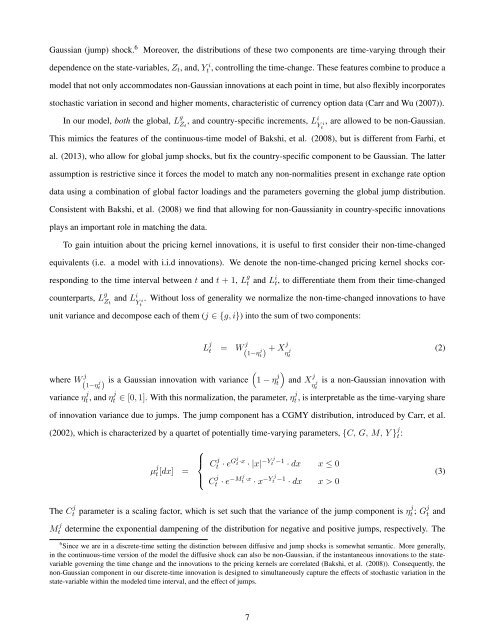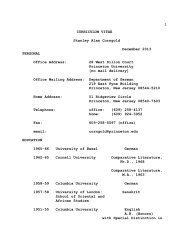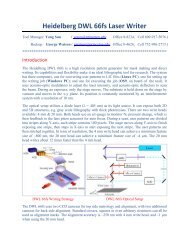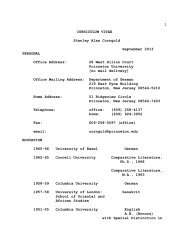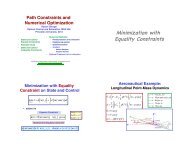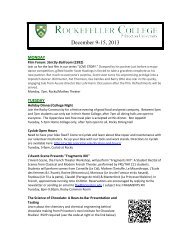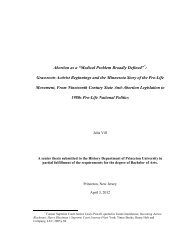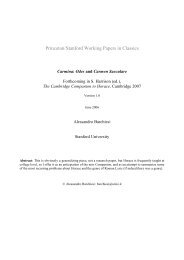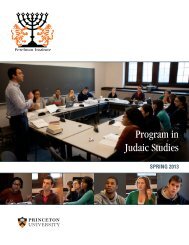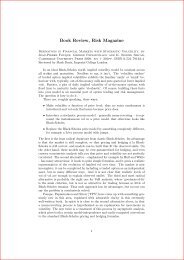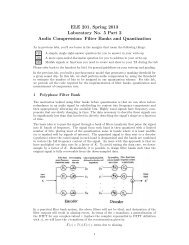Option-Implied Currency Risk Premia - Princeton University
Option-Implied Currency Risk Premia - Princeton University
Option-Implied Currency Risk Premia - Princeton University
Create successful ePaper yourself
Turn your PDF publications into a flip-book with our unique Google optimized e-Paper software.
Gaussian (jump) shock. 6<br />
Moreover, the distributions of these two components are time-varying through their<br />
dependence on the state-variables, Z t , and, Y i<br />
t , controlling the time-change. These features combine to produce a<br />
model that not only accommodates non-Gaussian innovations at each point in time, but also flexibly incorporates<br />
stochastic variation in second and higher moments, characteristic of currency option data (Carr and Wu (2007)).<br />
In our model, both the global, L g Z t<br />
, and country-specific increments, L i , are allowed to be non-Gaussian.<br />
Yt<br />
i<br />
This mimics the features of the continuous-time model of Bakshi, et al. (2008), but is different from Farhi, et<br />
al. (2013), who allow for global jump shocks, but fix the country-specific component to be Gaussian. The latter<br />
assumption is restrictive since it forces the model to match any non-normalities present in exchange rate option<br />
data using a combination of global factor loadings and the parameters governing the global jump distribution.<br />
Consistent with Bakshi, et al. (2008) we find that allowing for non-Gaussianity in country-specific innovations<br />
plays an important role in matching the data.<br />
To gain intuition about the pricing kernel innovations, it is useful to first consider their non-time-changed<br />
equivalents (i.e. a model with i.i.d innovations). We denote the non-time-changed pricing kernel shocks corresponding<br />
to the time interval between t and t + 1, L g t and Li t, to differentiate them from their time-changed<br />
counterparts, L g Z t<br />
and L i . Without loss of generality we normalize the non-time-changed innovations to have<br />
Yt<br />
i<br />
unit variance and decompose each of them (j ∈ {g, i}) into the sum of two components:<br />
L j t = W j (1−ηt) + j Xj η j t<br />
)<br />
where W<br />
(1 j<br />
(1−ηt) is a Gaussian innovation with variance − η j j t and X j η j t<br />
(2)<br />
is a non-Gaussian innovation with<br />
variance η j t , and ηj t ∈ [0, 1]. With this normalization, the parameter, ηj t , is interpretable as the time-varying share<br />
of innovation variance due to jumps. The jump component has a CGMY distribution, introduced by Carr, et al.<br />
(2002), which is characterized by a quartet of potentially time-varying parameters, {C, G, M, Y } j t :<br />
µ j t [dx] = ⎧<br />
⎪⎨<br />
⎪ ⎩<br />
C j t · eGj t ·x · |x| −Y j<br />
t −1 · dx x ≤ 0<br />
C j t · e−M j t ·x · x −Y j<br />
t −1 · dx x > 0<br />
(3)<br />
The C j t parameter is a scaling factor, which is set such that the variance of the jump component is ηj t ; Gj t and<br />
M j t<br />
determine the exponential dampening of the distribution for negative and positive jumps, respectively. The<br />
6 Since we are in a discrete-time setting the distinction between diffusive and jump shocks is somewhat semantic. More generally,<br />
in the continuous-time version of the model the diffusive shock can also be non-Gaussian, if the instantaneous innovations to the statevariable<br />
governing the time change and the innovations to the pricing kernels are correlated (Bakshi, et al. (2008)). Consequently, the<br />
non-Gaussian component in our discrete-time innovation is designed to simultaneously capture the effects of stochastic variation in the<br />
state-variable within the modeled time interval, and the effect of jumps.<br />
7


